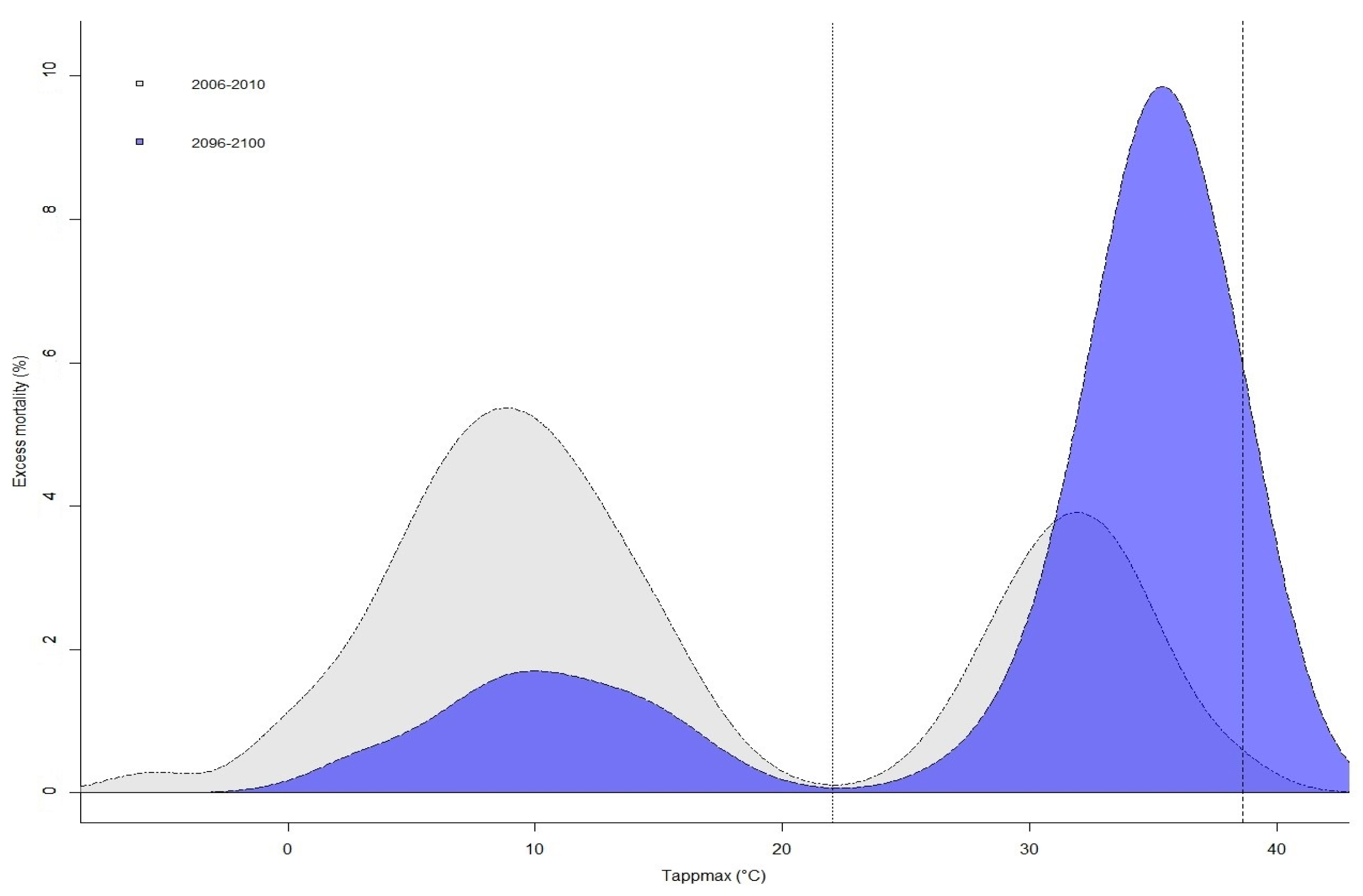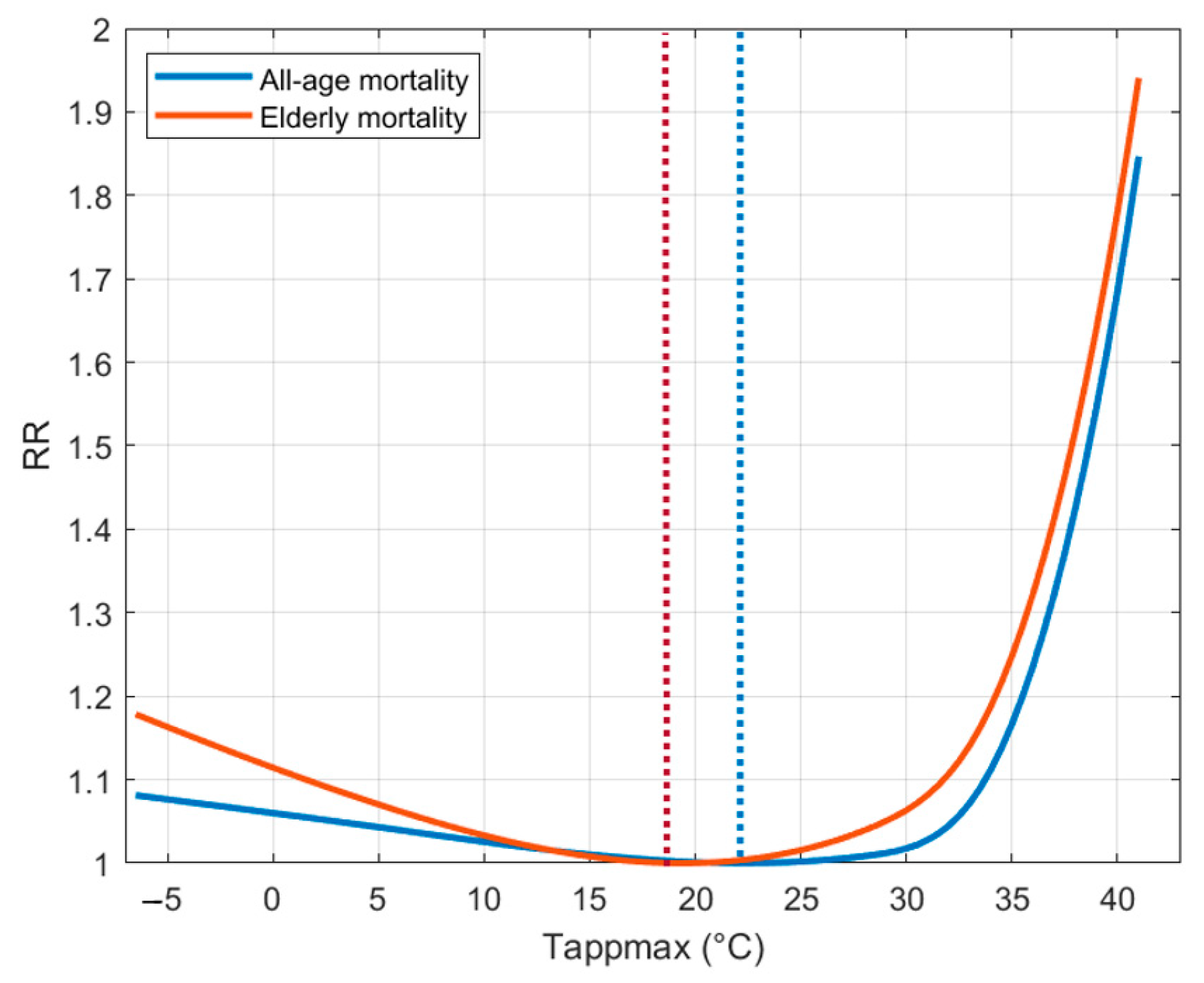Projections of Heat-Related Mortality under the Impact of Climate Change in Thessaloniki, Greece †
Abstract
:1. Introduction
2. Materials and Methods
2.1. Study Area
2.2. Data Analysis
3. Results and Discussion
3.1. Extrapolation of Exposure–Response Relationship and Quantification of the Projected Impact
3.2. Assessing the Projected Impact on the Elderly Population
4. Conclusions
Author Contributions
Funding
Institutional Review Board Statement
Informed Consent Statement
Data Availability Statement
Acknowledgments
Conflicts of Interest
References
- Nori-Sarma, A.; Benmarhnia, T.; Rajiva, A.; Azhar, G.S.; Gupta, P.; Pednekar, M.S.; Bell, M.L. Advancing our Understanding of Heat Wave Criteria and Associated Health Impacts to Improve Heat Wave Alerts in Developing Country Settings. Int. J. Environ. Res. Public Health 2019, 16, 2089. [Google Scholar] [CrossRef]
- McGregor, G.R.; Bessemoulin, P.; Ebi, K.; Menne, B. Heatwaves and Health: Guidance on Warning-System Development, No. 1142; McGregor, G.R., Bessemoulin, P., Ebi, K., Menne, B., Eds.; World Meteorological Organization and World Health Organization: Geneva, Switzerland, 2015. [Google Scholar]
- Koppe, B.; Kovats, C.; Jendritzky, S.; Menne, G. Heat-Waves: Risks and Responses; World Health Organization: Geneva, Switzerland, 2004. [Google Scholar]
- Gasparrini, A.; Armstrong, B.; Kovats, S.; Wilkinson, P. The effect of high temperatures on cause-specific mortality in England and Wales. Occup. Environ. Med. 2012, 69, 56–61. [Google Scholar] [CrossRef] [PubMed]
- Song, X.; Wang, S.; Hu, Y.; Yue, M.; Zhang, T.; Liu, Y.; Tian, J.; Shang, K. Impact of ambient temperature on morbidity and mortality: An overview of reviews. Sci. Total Environ. 2017, 586, 241–254. [Google Scholar] [CrossRef] [PubMed]
- Anderson, G.B.; Bell, M.L. Heat Waves in the United States: Mortality Risk during Heat Waves and Effect Modification by Heat Wave Characteristics in 43 U.S. Communities. Environ. Health Perspect. 2011, 119, 210–218. [Google Scholar] [CrossRef] [PubMed]
- World Health Organization. Heat Threatens Health: Key Figures for Europe. 2022. Available online: https://www.euro.who.int/en/health-topics/environment-and-health/Climate-change/archive/heat-threatens-health-key-figures-for-europe (accessed on 29 April 2022).
- Liu, L.; Breitner, S.; Pan, X.; Franck, U.; Leitte, A.M.; Wiedensohler, A.; von Klot, S.; Wichmann, H.-E.; Peters, A.; Schneider, A. Associations between air temperature and cardio-respiratory mortality in the urban area of Beijing, China: A time-series analysis. Environ. Health 2011, 10, 51. [Google Scholar] [CrossRef]
- Bunker, A.; Wildenhain, J.; Vandenbergh, A.; Henschke, N.; Rocklöv, J.; Hajat, S.; Sauerborn, R. Effects of Air Temperature on Climate-Sensitive Mortality and Morbidity Outcomes in the Elderly; a Systematic Review and Meta-analysis of Epidemiological Evidence. Ebiomedicine 2016, 6, 258–268. [Google Scholar] [CrossRef]
- Basu, R.; Dominici, F.; Samet, J.M. Temperature and Mortality Among the Elderly in the United States. Epidemiology 2005, 16, 58–66. [Google Scholar] [CrossRef]
- Chersich, M.F.; Pham, M.D.; Areal, A.; Haghighi, M.M.; Manyuchi, A.; Swift, C.P.; Wernecke, B.; Robinson, M.; Hetem, R.; Boeckmann, M.; et al. Associations between high temperatures in pregnancy and risk of preterm birth, low birth weight, and stillbirths: Systematic review and meta-analysis. BMJ 2020, 371, m3811. [Google Scholar] [CrossRef]
- Meehl, G.A.; Tebaldi, C. More Intense, More Frequent, and Longer Lasting Heat Waves in the 21st Century. Science 2004, 305, 994–997. [Google Scholar] [CrossRef]
- Gasparrini, A.; Guo, Y.; Sera, F.; Vicedo-Cabrera, A.M.; Huber, V.; Tong, S.; Coelho, M.d.S.Z.S.; Saldiva, P.H.N.; Lavigne, E.; Correa, P.M.; et al. Projections of temperature-related excess mortality under climate change scenarios. Lancet Planet. Health 2017, 1, e360–e367. [Google Scholar] [CrossRef]
- Vicedo-Cabrera, A.M.; Scovronick, N.; Sera, F.; Royé, D.; Schneider, R.; Tobias, A.; Astrom, C.; Honda, Y.; Hondula, D.M.; Abrutzky, R.; et al. The burden of heat-related mortality attributable to recent human-induced climate change. Nat. Clim. Chang. 2021, 11, 492–500. [Google Scholar] [CrossRef] [PubMed]
- D’Ippoliti, D.; Michelozzi, P.; Marino, C.; De’Donato, F.; Menne, B.; Katsouyanni, K.; Kirchmayer, U.; Analitis, A.; Medina-Ramón, M.; Paldy, A.; et al. The impact of heat waves on mortality in 9 European cities: Results from the EuroHEAT project. Environ. Health 2010, 9, 37. [Google Scholar] [CrossRef] [PubMed]
- Heaviside, C.; Vardoulakis, S.; Cai, X.-M. Attribution of mortality to the urban heat island during heatwaves in the West Midlands, UK. Environ. Health 2016, 15 (Suppl. S1), 49–59. [Google Scholar] [CrossRef] [PubMed]
- Keppas, S.; Parliari, D.; Kontos, S.; Poupkou, A.; Papadogiannaki, S.; Tzoumaka, P.; Kelessis, A.; Dimitrios, M. Urban Heat Island and Future Projections: A Study in Thessaloniki, Greece. In Environmental Protection and Disaster Risks; Dobrinkova, N., Gadzhev, G., Eds.; Studies in Systems, Decision and Control; Springer: Cham, Switzerland, 2021; Volume 361, pp. 201–212. [Google Scholar] [CrossRef]
- Giannakopoulos, C.; Le Sager, P.; Bindi, M.; Moriondo, M.; Kostopoulou, E.; Goodess, C. Climatic changes and associated impacts in the Mediterranean resulting from a 2 °C global warming. Glob. Planet. Chang. 2009, 68, 209–224. [Google Scholar] [CrossRef]
- Zanis, P.; Katragkou, E.; Ntogras, C.; Marougianni, G.; Tsikerdekis, A.; Feidas, H.; Anadranistakis, E.; Melas, D. Transient high-resolution regional climate simulation for Greece over the period 1960−2100: Evaluation and future projections. Clim. Res. 2015, 64, 123–140. [Google Scholar] [CrossRef]
- Georgoulias, A.K.; Akritidis, D.; Kalisoras, A.; Kapsomenakis, J.; Melas, D.; Zerefos, C.S.; Zanis, P. Climate change projections for Greece in the 21st century from high-resolution EURO-CORDEX RCM simulations. Atmos. Res. 2022, 271, 106049. [Google Scholar] [CrossRef]
- Kouis, P.; Kakkoura, M.; Ziogas, K.; Paschalidou, A.; Papatheodorou, S.I. The effect of ambient air temperature on cardiovascular and respiratory mortality in Thessaloniki, Greece. Sci. Total Environ. 2019, 647, 1351–1358. [Google Scholar] [CrossRef]
- Parliari, D.; Cheristanidis, S.; Giannaros, C.; Keppas, S.C.; Papadogiannaki, S.; De’donato, F.; Sarras, C.; Melas, D. Short-Term Effects of Apparent Temperature on Cause-Specific Mortality in the Urban Area of Thessaloniki, Greece. Atmosphere 2022, 13, 852. [Google Scholar] [CrossRef]
- Psistaki, K.; Dokas, I.; Paschalidou, A. Analysis of the heat- and cold-related cardiovascular mortality in an urban mediterranean environment through various thermal indices. Environ. Res. 2022, 216, 114831. [Google Scholar] [CrossRef]
- Kouis, P.; Psistaki, K.; Giallouros, G.; Michanikou, A.; Kakkoura, M.G.; Stylianou, K.S.; Papatheodorou, S.I.; Paschalidou, A. Heat-related mortality under climate change and the impact of adaptation through air conditioning: A case study from Thessaloniki, Greece. Environ. Res. 2021, 199, 111285. [Google Scholar] [CrossRef]
- Vicedo-Cabrera, A.M.; Sera, F.; Gasparrini, A. Hands-on Tutorial on a Modeling Framework for Projections of Climate Change Impacts on Health. Epidemiology 2019, 30, 321–329. [Google Scholar] [CrossRef] [PubMed]
- Armstrong, B.G.; Chalabi, Z.; Fenn, B.; Hajat, S.; Kovats, S.; Milojevic, A.; Wilkinson, P. Association of mortality with high temperatures in a temperate climate: England and Wales. J. Epidemiol. Community Health 2011, 65, 340–345. [Google Scholar] [CrossRef] [PubMed]
- Matthies, F.; Bickler, G.; Marin, N.; Hales, S. Heat–Health Action Plans-Guidance. 2008. Available online: http://www.euro.who.int/__data/assets/pdf_file/0006/95919/E91347.pdf (accessed on 21 January 2023).
- Parliari, D.; Giannaros, C.; Papadogiannaki, S.; Melas, D. Short-Term Effects of Air Pollution on Mortality in the Urban Area of Thessaloniki, Greece. Sustainability 2023, 15, 5305. [Google Scholar] [CrossRef]
- Psistaki, K.; Achilleos, S.; Middleton, N.; Paschalidou, A.K. Exploring the Impact of Particulate Matter on Mortality in Coastal Mediterranean Environments. SSRN Electron. J. 2022, 865, 161147. [Google Scholar] [CrossRef]
- Giannaros, T.M.; Melas, D. Study of the urban heat island in a coastal Mediterranean City: The case study of Thessaloniki, Greece. Atmos. Res. 2012, 118, 103–120. [Google Scholar] [CrossRef]



| Historical | Future | |||||
|---|---|---|---|---|---|---|
| Mortalities | Total | Heat | Cold | Total | Heat | Cold |
| All-age | 1.35 | 0.64 | 0.7 | 3.68 | 3.32 | 0.37 |
| Elderly | 2.87 | 1.79 | 1.08 | 5.67 | 5.14 | 0.53 |
Disclaimer/Publisher’s Note: The statements, opinions and data contained in all publications are solely those of the individual author(s) and contributor(s) and not of MDPI and/or the editor(s). MDPI and/or the editor(s) disclaim responsibility for any injury to people or property resulting from any ideas, methods, instructions or products referred to in the content. |
© 2023 by the authors. Licensee MDPI, Basel, Switzerland. This article is an open access article distributed under the terms and conditions of the Creative Commons Attribution (CC BY) license (https://creativecommons.org/licenses/by/4.0/).
Share and Cite
Parliari, D.; Keppas, S.; Papadogiannaki, S.; Papadopoulos, G.; Kontos, S.; Melas, D. Projections of Heat-Related Mortality under the Impact of Climate Change in Thessaloniki, Greece. Environ. Sci. Proc. 2023, 26, 72. https://doi.org/10.3390/environsciproc2023026072
Parliari D, Keppas S, Papadogiannaki S, Papadopoulos G, Kontos S, Melas D. Projections of Heat-Related Mortality under the Impact of Climate Change in Thessaloniki, Greece. Environmental Sciences Proceedings. 2023; 26(1):72. https://doi.org/10.3390/environsciproc2023026072
Chicago/Turabian StyleParliari, Daphne, Stavros Keppas, Sofia Papadogiannaki, Giorgos Papadopoulos, Serafeim Kontos, and Dimitrios Melas. 2023. "Projections of Heat-Related Mortality under the Impact of Climate Change in Thessaloniki, Greece" Environmental Sciences Proceedings 26, no. 1: 72. https://doi.org/10.3390/environsciproc2023026072
APA StyleParliari, D., Keppas, S., Papadogiannaki, S., Papadopoulos, G., Kontos, S., & Melas, D. (2023). Projections of Heat-Related Mortality under the Impact of Climate Change in Thessaloniki, Greece. Environmental Sciences Proceedings, 26(1), 72. https://doi.org/10.3390/environsciproc2023026072








